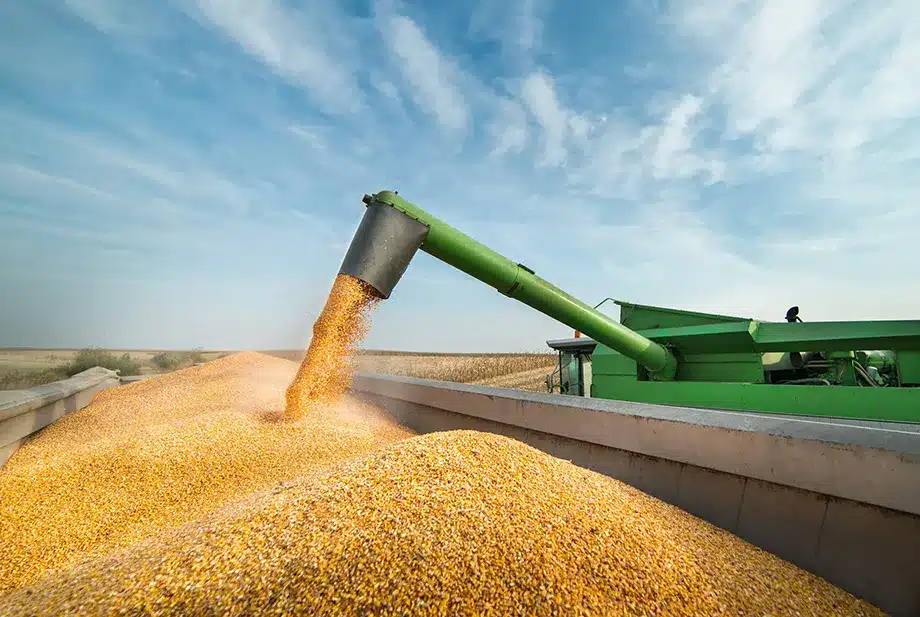Learn if you qualify for workers’ comp after a
grain entrapment injury in Charlotte
as well as other legal options
North Carolina’s agricultural industry is a vital part of the state’s economy, but working around grain is inherently dangerous. Perhaps the most serious risk for workers is grain entrapment accidents, which can happen in seconds and often lead to catastrophic injuries and death.
If you or someone you love has been injured or killed in a grain entrapment accident in North Carolina, it’s important to understand that you may be entitled to workers’ compensation benefits. This article will help you understand if you qualify for benefits and explore other legal options if you don’t qualify.
What is a grain entrapment?
Grain entrapment occurs when an individual becomes submerged in grain, usually within a storage bin, silo, or grain transporter, often as a result of walking on an unstable grain surface that suddenly shifts. This situation can happen quickly and is extremely dangerous, often leading to death within minutes from suffocation.
How common is grain entrapment?
Unfortunately, new reports show that grain entrapment accidents are on the rise in the U.S. According to a 2022 report by the Agricultural and Biological Engineering Department at Purdue University, there were at least 42 grain-related entrapments across the U.S. in 2022 alone, a 44.8% increase from 2021.
This is the highest number of grain entrapment accidents in the U.S. in more than a decade. North Carolina is among the states that experienced grain accidents that year, with 2 reported.
Overall, in 2022, there were at least 83 accidents involving agricultural confined spaces, a 40.7% increase from the 59 cases reported in 2021.
These incidents included grain entrapments as well as asphyxiations due to low oxygen levels or toxic environments, equipment entanglements while working inside confined spaces, and fires or explosions at grain handling facilities, which in total resulted in 24 deaths and 59 non-fatal injuries.
How do people get trapped in grain silos?
People can get trapped in grain silos in several ways:
- Walking on grain. This is the most common scenario, where an individual walks on top of the grain. The surface may appear solid, but it can be unstable and act like quicksand. Once a person starts sinking, the grain can engulf them quickly, making it difficult to escape.
- Avalanche. If grain is stuck to the sides of the silo and then suddenly breaks loose, it can engulf a person in seconds, similar to an avalanche.
- Falling into the silo. Individuals can also fall into a grain silo from an opening at the top or through access hatches, especially if proper safety barriers and precautions are not in place.
- Collapse of bridged grain. Sometimes, grain can form a crust or “bridge” at the top of a silo while there is a void underneath. If a person walks on this crust, it can collapse, dropping them into the void and burying them under the falling grain.
- Engulfment. This can occur when grain is being emptied from the bottom of the silo. If a person is on top of the grain, they can be quickly pulled down as the grain flows out, similar to how water drains from a bathtub.
In all these scenarios, the nature of grain can make it incredibly difficult for someone to breathe or move, making it crucial for workers to always work in pairs and be properly trained in the use of safety equipment like harnesses and lifelines.
Tennessee worker narrowly escapes death in grain entrapment accident
In December 2023, emergency crews successfully rescued a Tennessee worker entrapped in a grain bin after a call was received by the Etheridge Fire Department. The man was found with about 90% of his body buried in corn.
Using rescue tubes and a vacuum, the rescuers removed the corn to safely extract him through the bin’s access door. After the rescue, he was evaluated by a medical team and released, having suffered no serious injuries, as confirmed by the Lawrence County Fire & Rescue.
What is the most common cause of death in grain entrapments?
The most common cause of death in grain entrapments is suffocation. When an individual becomes trapped in a grain silo, the weight and shifting nature of the grain can quickly engulf and bury them, leading to suffocation within minutes. This is particularly likely if the grain is being moved or emptied at the time of the entrapment.
If a worker survives a grain entrapment, they might still suffer from a range of serious injuries. These can include crush injuries, broken bones, spinal cord injuries, and other physical trauma due to the force exerted by the grain, as well as respiratory issues from inhaling grain dust or particles and a lack of oxygen.
Survivors might also experience psychological trauma, such as post-traumatic stress disorder (PTSD), from the incident.
Am I entitled to workers’ comp after a grain entrapment accident in North Carolina?
In North Carolina, whether a farmworker receives workers’ compensation benefits after a grain entrapment accident depends on the size and nature of their employer’s business.
Specifically, a farmworker is eligible for workers’ compensation benefits if they work for an employer with 10 or more full-time, non-seasonal employees or if they are an H-2A worker (a temporary agricultural worker under the federal H-2A visa program).
Unfortunately, many farmworkers do not meet these criteria. Typically, only large or corporate farm operations employ 10 or more full-time, non-seasonal employees. As a result, a significant number of farmworkers in North Carolina, especially those working for smaller or family-run farms, may not be covered under the state’s workers’ compensation laws.
This means that in the event of a grain entrapment, these workers might not have access to workers’ compensation benefits unless they fall under one of the exceptions, such as being H-2A workers.
Understand Your Workers’ Compensation Rights in North Carolina
Learn about your rights under North Carolina’s workers’ compensation laws so you can get the compensation you deserve.
What workers’ comp benefits are available after a grain entrapment injury or fatality?
After a grain entrapment injury or fatality in North Carolina, if the farmworker is covered under workers’ compensation, several types of benefits might be available:
- Medical benefits. Workers’ compensation should cover all necessary medical expenses related to the grain entrapment injury. This includes hospital stays, surgeries, medications, physical therapy, and any other required treatments.
- Wage loss benefits. If the grain entrapment injury results in the worker being unable to work, they may be eligible for disability benefits. These benefits typically equate to two-thirds of the worker’s average weekly wage and are categorized into temporary total, temporary partial, permanent partial, or permanent total disability, depending on the severity and duration of the disability.
- Vocational rehabilitation. If the worker cannot return to their previous job due to their injuries, they may be eligible for vocational rehabilitation services, which can include job retraining, education, and other resources to assist them in returning to work in a new capacity.
- Death benefits. If a worker dies from a grain entrapment, their dependents may be entitled to death benefits, which usually include a portion of the worker’s wages and coverage for funeral expenses.
It’s important for affected workers or their families to consult with a workers’ compensation attorney to verify their eligibility for workers’ comp and ensure they receive all the benefits they’re entitled to, especially in cases involving serious injuries or fatalities.
What legal options are available for workers who don’t qualify for workers’ comp?
Farmworkers not covered by workers’ compensation may consider filing a personal injury lawsuit against their employer, a coworker, or an equipment manufacturer.
However, in a personal injury lawsuit, unlike in workers’ comp claims, the worker must prove fault. This means showing that the employer, coworker, or manufacturer’s negligence or intentional actions directly caused the injury.
For example, if an employer failed to provide necessary safety measures or a coworker acted recklessly, they could be held liable. Similarly, if defective equipment led to the injury, the manufacturer might be at fault.
If you believe one of these situations applies in your case, it’s essential to consult with a work injury attorney who can help establish fault and pursue appropriate compensation for damages such as medical expenses, lost wages, and pain and suffering.
Injured in a North Carolina grain entrapment accident? Wilder Pantazis Law Group can help!
If you or a loved one suffered injuries or a fatality from a grain entrapment accident in North Carolina, Wilder Pantazis Law Group is here to provide the assistance you need.
Our experienced team of attorneys specializes in workers’ compensation and personal injury law, ensuring you’ll receive the support and guidance necessary to navigate the complexities of your case.
We can help you file the necessary paperwork for a workers’ compensation claim and ensure all required steps are taken to secure the benefits you deserve. If workers’ comp is not an option due to your employment status, we can also explore other legal actions, such as personal injury lawsuits against responsible parties.
Our knowledgeable Charlotte work injury attorneys understand the nuances of proving fault and can advocate on your behalf for the best possible outcome.
Want to learn more?
Contact us today to learn how we can assist you in your recovery by scheduling a free consultation.
References
2022 Summary of U.S. Agricultural Confined Space-Related Injuries and Fatalities. (2023). https://www.purdue.edu/engineering/ABE/agconfinespaces/wp-content/uploads/2023/06/2022-Summary-of-US-Ag-Confined-Space-5-26-23.pdf


